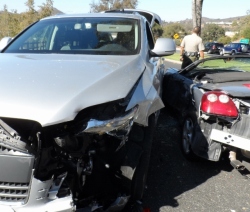exxxviii
Member
Yes I read that code. And, did you read that link you posted? You may not know, but there are four core types of automobile insurance: auto liability coverage,No. Did you read 11515? The only way you can claim salvage without it beping declared as a total loss by an insurance company is for you to be a self-insurer. Either $35k cash deposit with dmv or net worth over $2.2mil and 25 or more vehicles. Cars are insured, you don’t get to make unilateral decisions about them without the insurance company. Just because the section says an owner can declare doesn’t mean they aren’t claiming a legal definition. If you read the legal definition (since you want to quote vehicle code, there are legal definitions that you have to abide by when declaring a vehicle is salvaged), salvaged actually is Total Loss Salvage.
If your vehicle has not been determined a total loss salvage and you sign the form for the DMV, you are falsifying a legal government document. In the case of these vehicles, Tesla didn’t claim they were a total loss so they should be sold as a clean title. Them blacklisting them after the fact is BS. If they want to claim salvage, then they need to file the proper paperwork.

California Drivers Are Not Necessarily Required to Have Auto Insurance — Conejo Valley Guide | Conejo Valley Events
Yes, it is true, technically, the law does not state that drivers in California MUST carry auto insurance. However, California Vehicle Code Section 1656.2 does have certain "compulsory financial responsibility" requirements most easily met by maintaining valid auto liability insurancewww.conejovalleyguide.com
uninsured and underinsured motorist coverage, comprehensive coverage, and collision coverage. The only one legally required in CA (and most states) is liability coverage. The other three are optional. It is very common for owners of low value cars to drop uninsured motorist, comprehensive, and collision.
In this example above, you assume that Tesla has collision insurance. That may not be true. Its pretty common for fleet car operators to self-insure on collision, meaning they have enough cars that they choose to directly pay for repairs versus paying more overall for collision insurance on every car.
Not all cars are insured by collision, and if you choose not to carry collision, then yes, you can unilaterally make a total loss decision and yes, you can file directly with CA for only $15 to declare your car a total loss. That section 544(a) states exactly that "damaged, to the extent that the owner...considers it uneconomical to repair the vehicle." Nothing else matters. Car gets a scratch, you as its owner can declare it salvage. Heck, a car doesn't even need any damage, the law does not stop its owner from declaring it a total loss just because they want to. That would be economically foolish, but there is no further process required to put the brand on the title and report it to NVMTIS.


